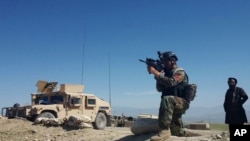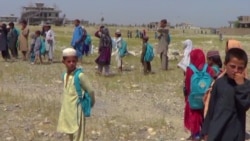As U.S.-Afghan forces pound Islamic State hideouts in their Nangarhar Province stronghold, civilians fleeing the fight say they’ve been left to deal with their plight alone.
The exact number forced out of their homes by the war against the so-called Islamic State Khorasan Branch (IS-KB) in Afghanistan is unknown, but officials in Nangarhar, where the war is concentrated, say thousands of households are displaced.
Most operations against IS-KB have been conducted in the rugged terrain of Achin District, where U.S. air force dropped the largest non-nuclear bomb ever used – known as the “mother of all bombs,” or MOAB – a week ago to destroy the militants’ tunnels.
“We left our fields and our homes in Achin after the planes dropped leaflets [to vacate the area],” a mother of four told VOA Afghan TV, adding that IS-KB fighters also were terrorizing residents.
Some displaced families have set up makeshift camps, while others have sought refuge in dilapidated buildings in and around Jalalabad city.
One young man, whose marriage was arranged at his home village in Achin District months ago, had to wed his bride in an empty room at a shelter house in Jalalabad.
“It was a wedding of sorrows,” said the groom, Rozijan “We were supposed to have a big wedding attended by all family members and loved ones in our own village.”
Displaced children are having trouble getting an education.
Amiristan was in eighth grade in Achin when his parents decided to flee to Jalalabad.
“When we got here, I wanted to register at a school, but they would not accept me,” the 14-year-old complained. “They were saying, `Where are your papers? We cannot accept you with no proof.’ I had no papers because we had to leave everything and just save ourselves… many of my friends quit coming to school because of the same reason.”
Bombs delivered, aid promises
At least 58,656 individuals fled their homes due to the conflict across Afghanistan from Jan. 1 to April 6, according to the United Nations Office for the Coordination of Humanitarian Affairs, adding to the 1 million who already have been displaced by conflict.
Aid agencies have appealed for $550 million to help the most vulnerable Afghans in 2017, including those affected by armed conflicts. As of April 19, donors had provided less than 20 percent of the target.
“To solve these problems, the National Security Council has promised us a budget. We will help them in various forms, give them some cash, needed material and build homes for them and provide education services,” said Ataullah Khogyanai, a spokesman for the governor of Nangarhar.
President Ashraf Ghani has vowed to eliminate IS-KB this year. U.S. and Afghan forces have killed up to 2,900 IS-KB fighters over the past 16 months, according to Afghan Defense Ministry figures.
Officials estimate the current IS-KB force at 1,000-1,500 men. The government’s strategy is to eliminate all of them.
While the war strategy is clear, neither the government nor its international allies have made public any contingency plans in response to the humanitarian consequences.
“Bombs are quick, and there are a lot, but aid never arrives to us,” said Gul Pacha, one of the displaced.






